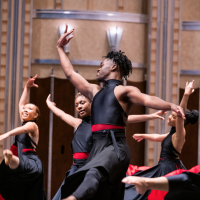In December 2007, the Cleveland Foundation hosted a meeting of the Arts Education Partnership (AEP), a non-political think thank and consortium of organizations supporting the arts in learning. At that meeting, AEP rolled out a major frame-changing concept: to create the ImagiNation – a nationwide, grassroots movement to create public will in support of arts education for all children.
This was only a concept, but AEP recognized that all the data-gathering, hand-wringing and pontificating by the arts community about the value of the arts had gotten us nowhere in decades past and was not likely to get us anywhere – ever. If there was to be positive change, ordinary people would need to value the arts in their hearts and minds. But how?
Last week at the spring Forum of the Arts Education Partnership in New Orleans, Eric Friedenwald-Fishman, a strategic communications expert, suggested the “how.” Through successful work in the areas of children and families, the environment, public health and human rights, Mr. Friedenwald-Fishman’s organization, Metropolitan Group, has developed a Public Will Framework to organize social impact campaigns to have long-term and movement-building influence.
Mr. Friedenwald-Fishman argued that the traditional uses of financial and institutional capital to leverage social change – in all areas of society – are no longer working. Institutions at the top of the social structure (foundations and cultural entities, even the National Endowment for the Arts) shouting about how important the arts are will not make a difference.
The example he gave of how institutional hierarchy and traditional policy and enforcement models cannot solve social problems hit very close to home. Thirty-five years ago, we (the nation) had a water pollution problem. Then (through Cleveland’s river catching fire, our lake’s death and the leadership of Ohio Sen. Louis Stokes) we passed the Clean Water Act. Government enforced the shutting down of 100,000 pipes that dumped toxic waste into our rivers. Hurrah!
But today, more rivers than ever are polluted, not from industrial sources but by every American impacting their local watershed with fertilizer, asphalt runoff, flushed prescription drugs, etc. And you can’t monitor and enforce laws for every single American. But now we have the widespread, diversely engaged environmental movement. Launched in countless ways by individuals and groups large and small, the movement informally develops common messages and shares information and passion, even across wide political divides.
In brief, Mr. Friedenwald-Fishman said that when individuals in communities are armed with information, are helped to imagine a different life than what they were born into, and are given the ability to engage with one another, public will can be built that can lead to change.
He said the frame of reference and the messages about the arts need to change. The arts must be re-framed in the context of social values. It’s not that children will do better in school if the arts are part of the curriculum. It’s that they will do better in life. The opportunity is for success, not just graduation. We need to reframe the concept of “achievement.” Achievement is not merely a score on a test. It is the ability to function in a world that requires creative thinking, problem-solving and learning to work with others.
“And when have we needed creative solutions and critical thinking more than now?” he asked. “You can’t have great science without creative thinking. You can’t be a great mathematician without practice in abstract thinking. You can’t be a leader in a diverse world without understanding different cultural references and points of view.”
Well, I get the need for the kind of grassroots, cross-political movement that both the ImagiNation concept and the Public Will framework outline. And I see that Mr. Friedwald-Fishman’s work may offer a strategy for implementation.
But I still believe there needs to be some leadership – not by fiat or regulation or enforcement. But somehow the information and messages need to be crafted and disseminated beyond the “choir.” Somehow the opportunities to bring diverse people together to imagine an alternative future for our children and engage in common action toward that future must be created. The match has to be struck and the dry grass lit for the ImagiNation to become a raging grassroots fire of change.
The conceptual work done by AEP in 2007, and the strategic ideas put forth at this year’s Forum, seem to be in alignment. Can we hope that leadership and a plan of engagement will emerge?
